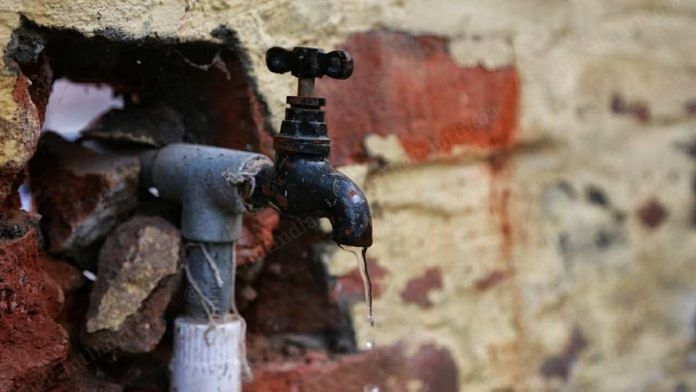Amid the second wave of Covid-19, recent headlines have highlighted the issue of lack of sufficient oxygen reserves in Delhi’s hospitals, since the demand for oxygen has increased manifold. As the national capital struggles for the lifesaving gas, the rise in Covid-19 cases calls for a check on other resources as well, such as water, whose demand has also gone up due to measures like hand-washing emerging as primary Covid-prevention ways.
Since the spread of coronavirus, there has been abundant stress on regular hand-washing and use of disinfectants, sanitisers, etc. Hand-washing in these times would increase the water demand at the household level by 20-25%. For an average family size of five, this additional amount has been estimated to be in the range of 100-200 litres per day, and is quite a burden on Delhi, which has not been able to bridge this demand-supply gap.
Delhi’s recurring water crisis
With the peak summer season having arrived, demand for water is already on the rise and supply is dwindling, making it difficult for both suppliers and users to manage with the limited resources.
Further, daily shutdowns due to maintenance and other work affect regular water supply, and most parts of the capital are suffering from limited or no supply for consecutive days. Questions about preparedness of the managers as well as the users arise every summer.
The Delhi Jal Board (DJB), which issued a warning in early 2021 that summer would be a difficult period this year, has yet to set up a real-time monitoring system for water supply that has been on its agenda since 2017. The installation of 3,200 flow meters at several locations to monitor water supply and identify losses has taken up quite some time. Implementation of such advantageous plans should be fast-tracked in order to prepare for the grim situation that Delhi faces every summer.
The problem of managing the increasing supply-demand gap and the government successfully implementing its programmes remains more or less the same every year. Nothing seems to move forward. Around 93 per cent of households in Delhi have access to piped water supply (Delhi Economic Survey, 2021), but details about number of hours and the quantum supplied to these connected households is usually missing.
There is inequitable distribution of water throughout the city, even in some of the affluent areas of the capital. To exacerbate the situation, about 40 per cent 0f treated water is lost during distribution, which is quite high. There is also the issue of poor water quality caused by pollution in upstream stretches of the Yamuna. The river receives a significant amount of untreated waste water, which is a huge cause of concern because Delhi’s primary source of water itself is being polluted.
These issues have been much talked about in the past as well, and there is a lot of information available about proposed and ongoing measures to overcome these challenges. However, the Covid-19 pandemic has made Delhi’s recurring water issue infinitely worse. Water is a much-needed resource to keep the coronavirus at bay. Thus, it is important to understand where we are falling behind.
Also read: In these Haryana villages, PM Modi’s Nal Se Jal has ended a painful daily chore for women
Water audit
The way the Supreme Court has ordered an oxygen audit of the oxygen supplies for states, it is similarly important to have water audits at the city-level. An audit can give us an idea about the amount of water available to a city, which can then help in planning distribution and management of the resource with maximum efficiency.
An audit helps in assessing the quantity and quality of water usage in different areas, at various stages of the distribution system. This important tool helps in identification of losses as well as areas of improvement in water-use efficiency. At the city-level, it is necessary to develop a strategy for regular measurement of the losses during distribution i.e., the Non-Revenue Water (NRW), along with measures for its reduction. This will not only help conserve the stressed resource but also save a lot of money for the Urban Local Bodies (ULBs). Minimising NRW could also be useful in addressing the supply-demand gap and avoiding the need to expand water sources or looking for new ones.
For example, in the case of Delhi, losing around 40 per cent of treated water is a huge loss to the system. If appropriate measures and suitable technological interventions are undertaken to reduce this loss, the demand and supply gap could be managed to a significant extent. Some of these measures include repairing leakages, curbing overflows in tanks and reservoirs, identification and regulation of illegal connections, automation of the supply system, etc. These interventions, to some extent, are included in the DJB’s plan of water audits that involve a real-time monitoring system, but speedy implementation is required in order to be prepared in times of crisis.
Additionally, without making concrete efforts to conserve water, there will always be uncertainty while managing future pandemics. Water is a pre-requisite for life and not only for drinking purposes; it is essential in maintaining hygiene that is important to stay safe and healthy. It is, therefore, suggested that utilities should be prepared for such emergencies with ready-for-action water conservation and resource management plans.
Another suggestion is to equip our essential institutions, like schools and hospitals, with their own water reserves and encourage and implement rainwater harvesting in all school, college, and hospital campuses. Their own reserves could help them survive a few days during times of crisis, without having to compromise on their services and operation.



